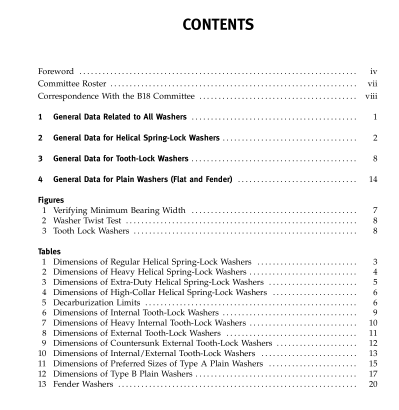ASME B18.21.1-2009 pdf free download.Washers: Helical Spring-Lock, Tooth Lock, and Plain Washers (Inch Series)
The corners at the inner and outer peripheries of the washers shall be slightly rounded. However, the extent of the rounding shall be such that the bearing width of the washer section is not reduced to less than the BW values shown in Tables 1 through 4. It is recommended that conformance to this limitation be determined by presetting a suitable caliper measuring device to the tabulated minimum bearing width dimension and com- paring the setting to the flat bearing face on each side of the washer as shown in Fig. 1.
2.6 Coiling: Helical Spring-Lock Washers Washers shall be coiled to form a helix. The gap and relationship of the severed ends shall be such as to pre- vent washers from tangling and to ensure that washers compress flatly. 2.7 Processing: Helical Spring-Lock Washers
2.7.1 Finishes: Helical Spring-LockWashers. Unless otherwise specified by the purchaser, lock washers shall be supplied with a plain (as-processed) finish, notplated or coated. Where corrosion preventative treatment is required, washers shall be plated or coated as specified by the purchaser. When helical spring-lock washers are to be furnished with coatings over 0.0005 in. thick and are to be used with bolts or screws also having thicker coatings, they are to be coiled to limits of 0.020 in. in excess of those specified in Tables 1 through 4 for mini- mum inside diameter and maximum outside diameter. Heavy coating of washers under 1 ⁄ 4 in. nominal size is not recommended.
2.7.2 Embrittlement: Helical Spring-Lock Washers. Electroplating carbon and boron steel-lock washers is notrecommended because ofthe possibilityofhydrogen embrittlement failures. When the purchaser specifies electroplated lock-washers they must be baked after plating using times and temperatures suitable for reliev- ing potentially trapped hydrogen. All lots of electro- plated lock-washers shall be tested bycompressingthem to a flat condition for a minimum of 48 hr, within which time they must not fracture. Compression shall be accomplished between parallel flat surfaces.
2.8 Workmanship: Helical Spring-Lock Washers The flat surfaces (faces) of helical spring-lock washers shallbe free fromsuchsurface imperfections as knurling, serrations, die marks, deep scratches, loose scale, burrs, or other irregularities that would affect serviceability. Moderate feed roll marks shall be permissible on the outer periphery.
2.9 Twist Tests: Helical Spring-Lock Washers The washer shall be gripped in vise jaws. The ends of the washer shall be free, and an axis passing through the slot shall be parallel to and slightly above the top of the vise so less than 50% of the washer is gripped. A 90-deg maximum segment of the free end of the washer shall be gripped in wrench jaws so at least 25% of the washer is exposed when twisting, as shown in Fig. 2. Edges of the wrench jaws shall be in a plane parallel to the vise. Movement of the wrench that increases the free height ofthe spring-lock washer shall twist carbon steel, boron steel, and alloy steel washers through an angle approximating 90 deg, and corrosion resistant steel and nonferrous washers through an angle approximating 45 deg with no sign of fracture.
3 GENERAL DATA FOR TOOTH-LOCK WASHERS
3.1 Application: Tooth-Lock Washers The tooth-lock washers covered in this Standard are intended for generalapplication. The tooth-lockwashers serve to increase the friction between the screw and the assembly. Internal tooth-lock washers are preferred where it is desirable to provide a smooth periphery.
3.2 Tooth Design: Tooth-Lock Washers The selection of Type A or Type B tooth designs as shown in Fig. 3 and in Tables 6 through 10 shall be at the manufacturer’s option unless a specific design is designated by the purchaser. The number of teeth, the length of the teeth, the width ofthe rim, and the thickness of the washer over the teeth (free height) shallbe optional withthemanufacturer. The projection of the teeth on both sides of the washer shall be relatively uniform.
3.3 Styles and Dimensions: Tooth-Lock Washers Dimensions for the various types of washers are as follows; internal tooth-lock washers (Table 6), heavy internal tooth-lock washers (Table 7), external tooth-lock washers (Table 8), external tooth countersunk washers (Table 9), and internal/external tooth lock washers (Table 10).ASME B18.21.1 pdf download.ASME B18.21.1-2009 pdf free download
